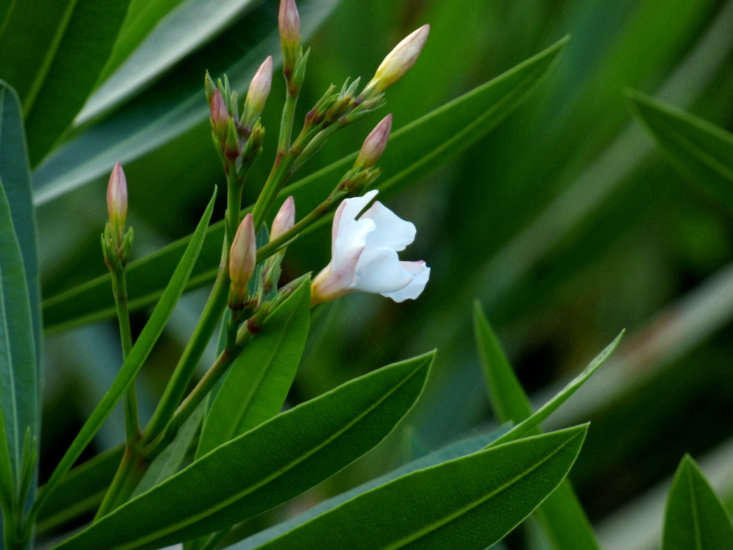Oleander, Nerium oleander
“Oleander” rhymes with “I can’t stand her,” as anyone familiar with the lyrics of Steely Dan’s “My Old School” knows. Great rhyme, guys, and just so you know, I’ve been unable to get it out of my mind for the past four decades. So, thanks for the song.
And thanks for the warning. Technically the complaints in the song are about a girl, not a shrub with fragrant clusters of pink or white flowers, but one does well to remember that oleander has a dark side. All parts of the Nerium oleander plant contain the chemical oleandrian and are poisonous—leaves, flowers, bark, etc.—to humans and other mammals. (As the Los Angeles Times warns, do not “use it to skewer meat for barbecues.”) Although deaths are rare, a terrible double toddler poisoning occurred in southern California in 2000: two brothers recently adopted from Russia were found dead in their cribs after chewing on leaves from a neighbor’s oleander bushes.
Does this mean you should not plant oleander in your garden? If you have small children, you may want to consider a different flowering shrub. On the other hand, oleander is one of the most common shrubs—grown in warm climates from the south of France to the coast of California—and like other plants that are toxic if ingested, will not hurt you if you don’t eat it or try to smoke it. (Oleander did not make the American Association of Poison Control Center’s top-20 list of most frequently reported plant exposes in 2016, the most recent year for which data is available.)
Read on for everything you need to know about oleanders.

Oleander thrives in USDA growing zones 8 to 11 and has either white or pink flowers. An exceptionally hardy plant, once established, leggy oleander will spring back into shape after a hard pruning and grows as much as two feet a year to create a dense, attractive screen. With long, slender leaves that look like the foliage of an olive tree, oleander is graceful in shape and in size (at maturity it reaches a height of about 20 feet).

When did oleanders, natives of Mediterranean climates, arrive in the United States? We turn to the International Oleander Society (established in 1967) to learn that Texas played a key part in the story: “The first oleanders came to subtropical Galveston in 1841. Joseph Osterman, a prominent merchant, brought them aboard his sailing ship from Jamaica to his wife and to his sister-in-law, Mrs. Isadore Dyer. Mrs. Dyer found them easy to cultivate and gave them to her friends and neighbors. The familiar double pink variety that she grew has been named for her.”
The rest is more history.

“Due to the preserving layers of volcanic ash from the eruption of Mount Vesuvius, we know that oleanders were also grown in the gardens of Pompeii,” according to the International Oleander Society. “They were the plant most often painted on Pompeian murals (circa 79 AD) and were usually found represented in informal settings as background plants or mass plantings in the unique, traditional garden wall paintings whereby the Pompeians created the illusion that their gardens extended far into the countryside.”
Cheat Sheet
- For a cold-hardy cultivar that can survive winters in USDA Zone 7, consider Nerium oleander ‘Hardy Pink’ with candy-colored flowers.
- For double flowers, consider N. oleander ‘Mrs. Lucille Hutchings’.
- In colder climates, keep oleander in pots and move the plants to a protected spot or indoors in winter months.
- Drought resistant, oleander is frequently planted along highways and thoroughfares as a screening plant and windbreak.

Keep It Alive
- Oleander prefers full sun but will tolerate some shade; well-drained soil is a requirement.
- Prune in late winter while dormant; oleander flowers on new growth.
- Train dwarf varieties to grow as a low hedge (which will need to be shaped at least twice a year). Consider compact ‘White Sands’ for a variety with white flowers.
See more growing tips in Oleander: A Field Guide to Planting, Care & Design in our curated design guides to Shrubs 101. Read more:
- True Colors: 9 Best Shrubs for Fall Foliage
- Ask the Expert: Will a ‘Poisonous’ Plant Really Kill Your Pet?
- Everything You Need to Know About Shrubs
- Pittosporum: A Field Guide to Planting, Care & Design









Have a Question or Comment About This Post?
Join the conversation (1)